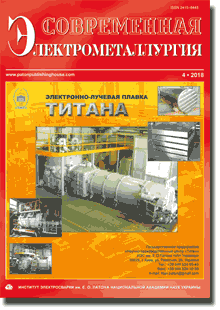| 2018 №04 (04) |
DOI of Article 10.15407/sem2018.04.05 |
2018 №04 (06) |

Electrometallurgy Today (Sovremennaya Elektrometallurgiya), 2018, #4, 62-69 pages
Peculiarities of structure formation of products, obtained in electron beam 3D printer, at applying the titanium alloy wire
D. V. Kovalchuk, G. M. Grigorenko, A. Yu. Tunik, L. I. Adeeva, S. G. Grigorenko, S. N. Stepanyuk
E.O. Paton Electric Welding Institute of the NAS of Ukraine 11 Kazimir Malevich Str., 03150, Kyiv, Ukraine. E-mail: office@paton.kiev.ua
Presented are the results of investigations of peculiar features of formation of metal structure of products, produced by the method of additive technology in the electron beam 3D printer with applying the titanium wire. As an initial material for surfacing, the titanium wire of 2 or 3 mm diameter of alloy VT6 was used. The substrate was a plate of 12.5 mm thickness of the same alloy. The general regularities of structure formation of specimens, produced for one, two and three parallel passes were considered.. It is shown that in the primary structure of product of a cast type the equiaxial grains are dominated. The secondary structure of grains of an acicular type is presented by two phases: ά — low-temperature martensitic (FCC is approximately 99.0 wt.%) and β — high-temperature (BCC is 1.0 wt.%). It was found that during the process of wire deposition the aluminium losses are minimum. The heat treatment of products leads to more equilibrium state of the structure. The mechanical tests of specimens showed a good level of main mechanical properties both along and also across the deposited layers. The results, given in the work, demonstrate the future prospects of the additive technology «xBeam 3D Metal Printing» for producing 3D products of titanium alloys. Ref. 8, Tabl. 1, Fig. 9.
Key words: additive technologies; electron beam; 3D printing; titanium alloys; deposited layers; structure; mechanical properties
Received: 03.10.18
Published: 15.11.18
References
1. Kovalchuk, D.V., Melnik, V.I., Melnik, I.V., Tugaj, B.A. (2017) New possibilities of additive manufacturing using xBeam 3D Metal Printing technology (Review). The Paton Welding J., 12, 16-22. https://doi.org/10.15407/tpwj2017.12.03
2. Zhukov, V.V., Grigorenko, G.M., Shapovalov, V.A. (2016) Additive manufacturing of metal products (Review). Ibid., 5–6, 137–142. https://doi.org/10.15407/tpwj2016.06.24
3. Rizwan Ali, P.M., Hara Theja, C.R., Syed Mahammad Syed Saheb, Yuvaraj, C. (2015) Review on diverse materials applied for additive manufacturing. Int. J. for Research in Applied Sci. and Engin. Technol., 3, Issue 7, July, 16–20.
4. (2016) Method of manufacturing of 3D objects and device for its realization. Pat. 112682 C2, Ukraine [in Ukrainian].
5. Grabin, V.F. (1975) Fundamentals of materials science and heat treatment of welded joints of titanium alloys. Kiev, Naukova Dumka [in Russian].
6. Baranova, L.V., Demina, E.L. (1986) Metallographic etching of metals and alloys. Moscow, Metallurgiya [in Russian].
7. Tur, A.A. (2003) Metallurgy of titanium. Kiev, Metalagrotrade [in Russian].
8. Iliin, A.A., Kolachev, B.A., Polkin, I.S. (2009) Titanium alloys. Composition, structure, properties: Refer. Book. Moscow, VILS-MATI [in Russian].
